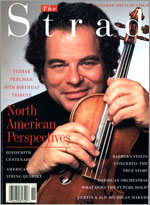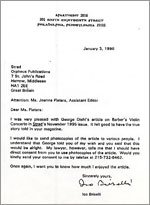A TALE of THREE MOVEMENTS
By Dr. George K. Diehl
—The Strad Magazine, 1995
pg. 1117 "Contrary to Nathan Broder's report - promulgated in other writings - that Briselli 'complained that the music was too simple and not brilliant enough for a concerto,' Briselli's response was one of enthusiasm and admiration. The third movement was finally submitted to Briselli in mid-summer of 1940. Briselli's initial reaction was that as a moto perpetuo it did not match in quality or substance the first two movements, and did not give a sense of 'belonging'. It appeared to him not to be a fitting close to the concerto, and Briselli suggested to Barber that he might perhaps consider revising the movement by expanding it and giving it more clearly defined structural parameters. Barber, however, declined to alter it. ..Nor after its completion, did he say that it was too difficult or unplayable. In the 1920s, 1930s, and in 1940 Briselli was soloist with the Philadelphia Orchestra in concertos by Paganini, Bruch, Mendelssohn, Beethoven, and Dvorak, and included in his repertory the virtuoso works of such composers as Vieuxtemps, Ysaye, Sarasate and Wieniawski. Performing these to critical acclaim, his technical ability was never questioned. His discussions with Barber concentrated solely on the appropriateness of the movement".
pg.1118 "...reports concerning the 'testing' of the third movement should be corrected. Broder, for example, states that Oscar Shumsky (Broder i—s in error in the identification of the violinist) was called in to perform the finale "for the merchant and his protégé" to prove that it was playable. No one, in fact, ever performed the finale for Briselli and Fels. The story has its origins in an occurrence at the Curtis Institute when violinist Herbert Baumel, a student of Lea Luboschutz, was prevailed upon by a member of the Curtis faculty to prepare the third movement with two hours' notice and perform it before a small Curtis committee to show that it presented no insurmountable technical hurdles. This proof of playability was successfully carried out by Baumel (playing through approximately half of the movement), despite the fact that Briselli never expressed any concern about the movement's difficulty. Neither Briselli nor Fels were aware of this 'testing' until afterwards.
Barbara Heyman relates that,' Even after completing the violin concerto, Barber still had reservations about the technical feasibility of the final movement'. The statement suggests that Barber himself was not totally convinced about the finale and one wonders if that is what prompted the Baumel incident. Briselli conjectures that Barber was perhaps trying to find a justification for the movement and that Briselli's remarks to Barber might have given Barber cause for concern.
Early critical opinions of performances of the concerto speak glowingly of the first two movements but are divided about the finale. Reviewers' and other writers' comments about the substance and propriety of the third movement have persisted in making it a controversial one".
Iso Briselli's Response
Iso Briselli's letter to Strad Magazine, January 3, 1996.
[ home ]







